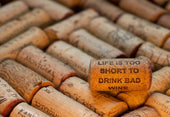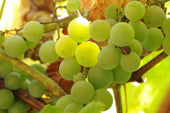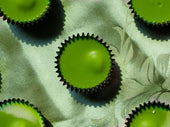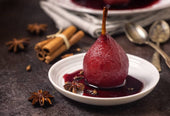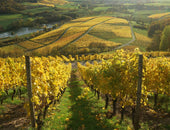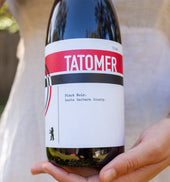
Pinot Noir: A Love Affair for the Ages

By Iris Rowlee
People love Pinot Noir; so much so that it was the first fruit crop to ever have its genome mapped, so much so that there is an international holiday on August 18th just to celebrate it’s very existence. A grape that is thought to be Pinot Noir was referenced in writing in the first century A.D., around the time Romans introduced the idea of viticulture to modern day France, making humans' relationship with it is as old as modern history.
There are thousands of varieties of Vitis vinifera wine grapes. Pinot Noir is one of the oldest and most prolific great granddaddies of the whole lot. Just for reference, Cabernet Sauvignon is 1000 years younger. The list of Pinot Noir’s successful and beloved progeny is so great that the family tree stemming from it can be mind boggling and surprising but we’ll get into that more later. Rather than having domesticated wine grape parents itself, Pinot Noir is thought to be a descendant of the ancient wild vine, Vitis sylvestris.
Pinot Noir, like many grape names, makes reference to its visual appearance in the vineyard. Pinot comes from the french word pin for pine, referencing its pine cone shaped, small, tightly clustered grape bunches and Noir, meaning black and thus referencing a dark, red grape variety. It’s skin is very thin, contributing to it’s delicate nature and signature translucent ruby hue. Higher acid and lower tannin, it’s signature red fruit and particular balance of floral, spice and earth notes often make it an easy ID in blind tastings, no matter where it’s from in the world. Pinot Noir has a great ability to clearly convey each unique environment it’s planted in, aromas of it’s terrior coming through in the wine, while still maintaining a true expression of its spunky personality.
Indigenous to Burgundy, France, it’s now grown the world over, with excellent expressions found in far reaching lands like New Zealand and Chile. The greatest majority of Pinot Noir is still grown in France, followed very closely in acreage by the US, and third by Germany, where it’s called Spätburgunder. Preferring a long, cool growing season, it does well in areas with protective valleys or climate tempering water nearby. Nicknamed the heartbreak grape for how difficult it is to successfully grow, the fact that it is the 10th most planted grape in the world shows humanity’s dedication to it.
Napa Valley winemaking pioneer Andre Tchelistcheff, nicknamed the “dean of American winemakers” once famously said that, "God made Cabernet Sauvignon whereas the devil made Pinot Noir”. Cabernet’s reputation in the vineyard is as hardy and pretty easy going, whereas Pinot is delicate and prone to problems. It is very sensitive to its surrounding climate, vulnerable due to early budding and ripening, susceptible to virus and disease and therefore prone to genetic mutation. It is from this genetic variance that a great bounty was born unto us (us being the vinophiles) and many say that it’s genetic diversity is what can be attributed to it having a much longer and more prolific history as a cultivated vine than other varieties. Let me explain.
First of all, the grape varieties Pinot Blanc and Pinot Gris have the same basic genetic identity as Pinot Noir; they are simply genetic color mutations that occurred over time and came into their own personalities. Along these lines, Pinot Meunier is derived from a chimeric mutation of Pinot Noir (which could be a whole conversation unto its own for another day).
Secondly, there was a powerful unsung love story of a prince and a commoner in the Middle Ages in France that led to great prosperity. Pinot Noir, the grape darling of the nobility of the time, was tended with great pomp by the church in walled off sub zones, or clos. Gouais Blanc, also an ancient variety, and a very productive and vigorous vine revered by the masses, was plentifully planted at the time, often in very close proximity to Pinot. Eventually, as nature would have it, sparks, or shall we say pollen, flew, and natural crossings of the two made them the proud parents of many a variety we know and love today, the most notable offspring being Chardonnay, Aligote, and Gamay. Did anyone else just have the thought creep into their mind that there would be no Champagne without Pinot? Oh my!
Now let's take a little time to discuss Pinot Noir’s native habitat and some of the noteworthy places it calls home around the world, with thoughts on palate typicity and a recommended wine of the region.
It was in the Middle Ages that Pinot Noir came into its own. The Cisterian monks who were tasked by the Catholic church in France with making the wine did much to advance its cause and created the idea of terrior as we know it. This is the concept of different subzones of the vineyards or ‘clos’ having their own unique environmental factors that affect the vines and in turn the characteristic tastes and flavors imparted to a wine. These clos the monks demarcated so long ago still stand, many as top tier sites. This area in Burgundy, called the Côte d’Or, follows the hills south of the city of Dijon (where the ruling elite were based), and is Pinot’s proverbial throne. It’s most highly lauded vineyards in the world perch on the eastern slope of the hills facing the Saône River Valley. The soil here is very unique and lends a special character to its overall terrior. 200 million years ago the hills of Burgundy were home to a tropical sea. Time solidified the seabed to limestone, Pinot’s favorite soil, and to this day the vineyards are studded with fossilized marine flora and fauna.
The flavor profile of French Pinot is fresh red fruit, earth, mushroom, rose petals, savory herbs. Is it typically a lower alcohol, less oaked, lighter, brighter style than New World expressions.
Oregon Pinot NoirOregon is home to the region most like Burgundy, in the sense that its predominant red grape is Pinot Noir and it has an increasing breakdown of the sub regions with identifiable, unique style profiles. This area is the Willamette Valley and in June of this year it gained two new American Viticultural Areas or AVAs, Tualatin Hills and Laurelwood District bringing the total number of sub-appellations to 9. Starting near Portland, the Willamette Valley is a 120 mile stretch extending south between two mountain ranges, the Cascades and the Coastal Range. It is a cool climate for Pinot Noir and the styles though ripe compared to France are often lighter and brighter, more earth driven and with greater vintage variation than it’s sunny sister to the south, California’s appellations. Dark berries, violets and more woodsy notes typify the style.
California is home to most of America’s Pinot Noir plantings and there are many regions it grows in. The most known regions though are all united by receiving the cooling effect of the Pacific Ocean. California’s newest AVA is the Petaluma Gap, which is a Pinot Noir and Chardonnay dominant region in southern Sonoma county characterized by the wind swept ocean fog that funnels in through a coastal mountain opening down to the San Pablo Bay where it passes over another dominant region, Carneros. Further south the Santa Cruz mountain bask in the fog, and in Santa Barbara, home to the longest grape growing season in California, its most notable Pinot appellation, the Sta Rita Hills, is tempered by ocean fog and breezes and nurtured with lots of mid day sun and limestone rich soil. Anderson Valley is one of California’s coolest growing climates, pulling Mendocino coast fog up the Navarro River and into its insulating, rugged hills. The Russian River is one of the warmer highly regarded Pinot appellations, following its namesake river through alluvial and sandy loam soils and creating lush, round Pinots. In general California Pinot Noirs are the most opulent of the styles not just because of the sunny climate but because of a predominance of new French oak barrel aging added structure and aromatic notes like toasted vanilla, nutmeg and allspice to the fruity, deeply concentrated berry and cherry flavors with floral notes and black tea.
Chile has been making wine for 500 plus years, where warm weather thriving Cabernet Sauvignon is king, but in the last 20 years there has been major growth in cool climate, southern coastal influenced appellations for the likes of Pinot Noir’s fancy. Valle de Casablanca DO, Valle de Leyda DO, Valle de Bio Bio DO are examples. The Leyda Valley DO or Denomination of Origin is a wine appellation in the hills of Chile’s Coastal Mountain Range undulating down to the Pacific Ocean. From the capital city, Santiago, one would take the aptly named Autopista del Sol or Highway of the Sun southwest for about sixty miles to find themselves in a paradise of green hills and vines reaching down to the beaches. The Chilean coast has particularly cold water in this area due to the Humboldt Current which flows up from the Antarctica chilled waters of further south and causes cold air to blow inland tempering the weather, and capping average peak summer temperatures at a pleasant 75 F. The Pinots from here can be quite spicy, zippy little numbers, lighter bodied than their North American counterparts, with tart cherry, raspberry, pomegranate and wildflowers giving way to a green herbal note, flint smoke, peppercorn and granite minerality.
These are just a couple stories of this well travelled friend of ours.. And in case you were wondering about who stands where in this relationship, Pinot Noir has about 30,000 genes in its DNA whereas the human genome only contains some 20,000 to 25,000 genes. One point to Pinot Noir.

This article was contributed by Iris Rowlee. She is a Court of Masters certified Sommelier, a Vinitaly International Academy Italian Wine Ambassador, and a 3iC Certified Educator.






